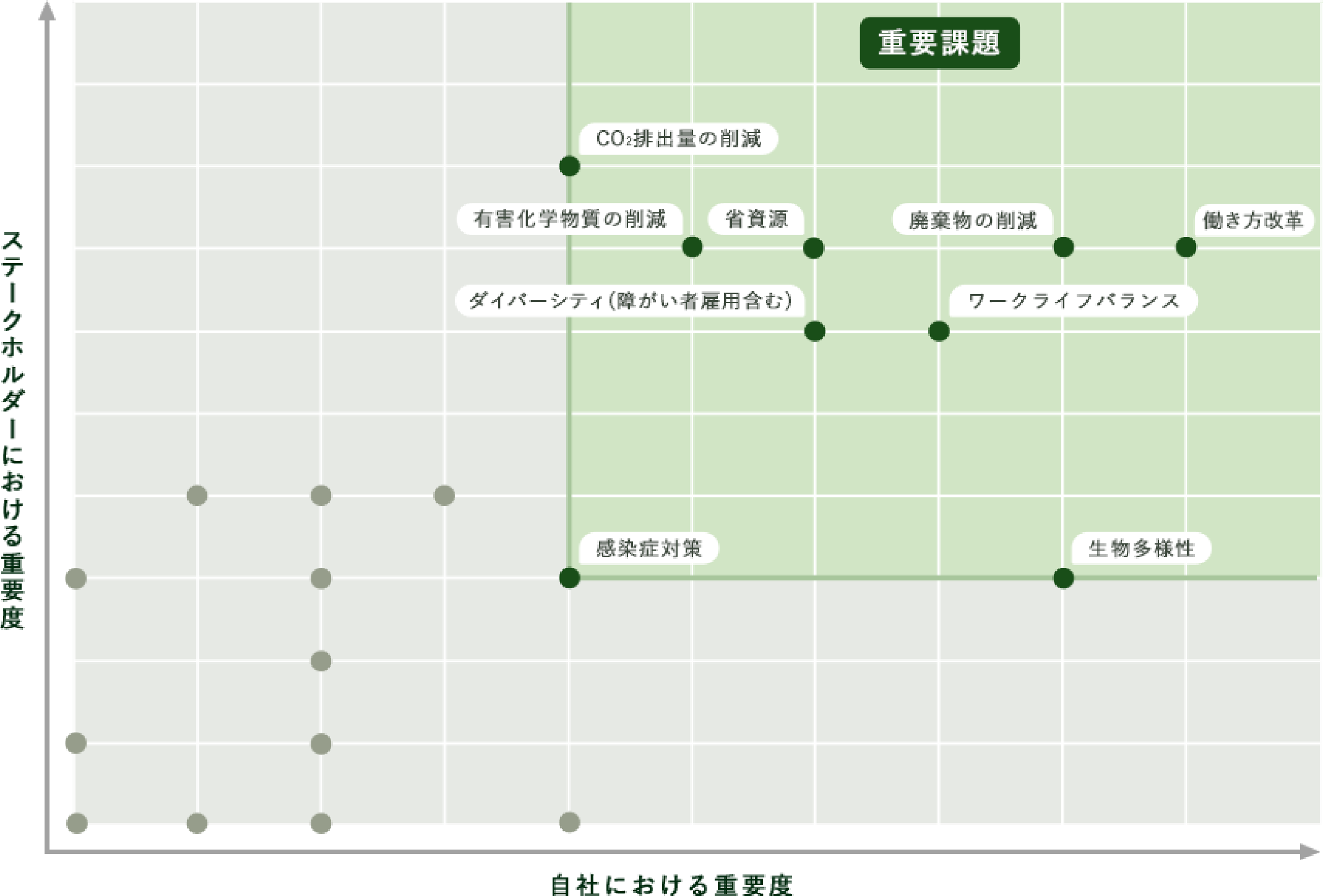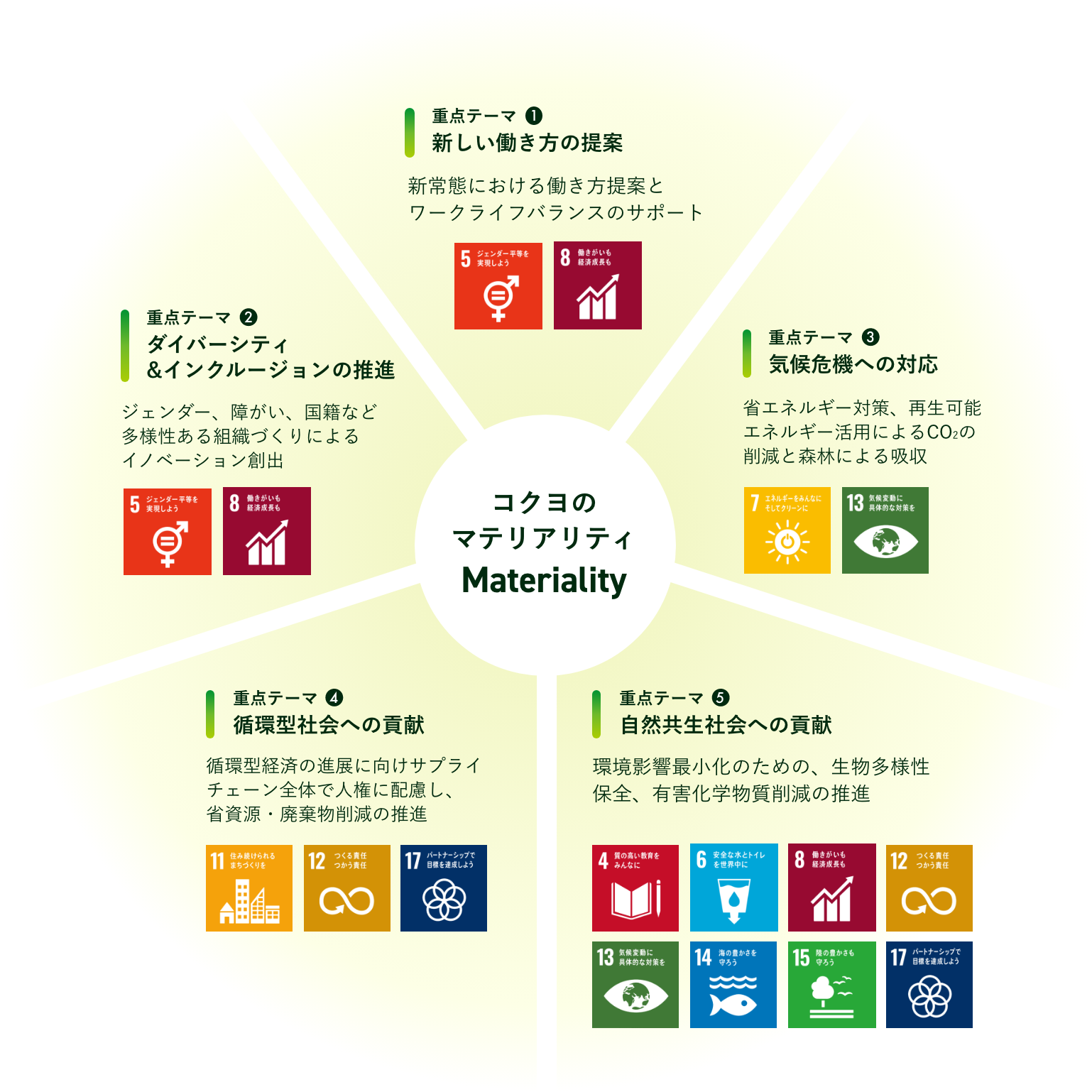サステナビリティマネジメント
マテリアリティ特定プロセス2020
マテリアリティ特定プロセス(2020年~2021年)

-
※ESG:環境(Environment)・社会(Social)・企業統治(Governance)の頭文字
STEP1 ESG視点での課題の抽出
SDGs、MSCI、SASBなどを参考に環境・社会・ガバナンスにおいて34の重要なマテリアリティ候補を抽出しました。
| 各視点 | アンケート | デスクリサーチ | |
|---|---|---|---|
| ステークホルダー軸 | 消費者 | ◯ | ― |
| 重要顧客 | ◯ | ― | |
| 投資家(MSCI・SASB) | ― | ◯ | |
| 国・自治体(成長戦略) | ― | ◯ | |
| 自社軸 | 商品・サービス・CSR項目のSDGs貢献度 | ― | ― |
| 自社開発部門 | ◯ | ― | |
| 経営層 | ディスカッション |

-
※SDGs:Sustainable Development Goals MSCI:Morgan Stanley Capital International
SASB:Sustainability Accounting Standards Board CSR:Corporate Social Responsibility
STEP2 ステークホルダーへの影響分析
抽出したマテリアリティ候補項目について、「ステークホルダーにおける重要度」「自社における重要度」の2つの軸で調査を実施し、点数化した後で、両軸における点数が一定値を超えるものをマテリアリティ(重要課題)として特定しました。
マテリアリティマップ

STEP3 経営層によるマテリアリティの妥当性検討
その後経営層で、特定されたマテリアリティの妥当性を検討しました。

STEP4 マテリアリティと目標の設定
特定したマテリアリティを踏まえて、2020年に2030年目標を設定しました。
| マテリアリティ | 2030年目標 | |
|---|---|---|
| 重要テーマ1 新しい働き方の提案 |
新常態における働き方提案とワークライフバランスのサポート | 社員一人ひとりが自律し、チームで課題解決する企業になっている |
| 重要テーマ2 ダイバーシティ&インクルージョンの推進 |
ジェンダー、障がい、国籍など、多様性ある組織づくりによるイノベーション創出 | 多様な人財がそれぞれの個性·能力を発揮できる企業になっている |
| 重要テーマ3 気候危機への対応 |
省エネルギー対策、再生可能エネルギー活用によるCO2の削減と森林による吸収 | CO2吸収:6,000t-CO2以上/年の吸収量に貢献する |
| CO2排出量の削減:2013年比で2030年にCO2排出量を26%削減する | ||
| 重要テーマ4 循環型社会への貢献 |
循環型経済の進展に向けサプライチェーン全体で人権に配慮し、省資源·廃棄物削減の推進 | 廃棄物(事業所、施工現場、棚卸在庫)のリサイクル率100% |
| 調達方針のグループ全体での運用 | ||
| 重要テーマ5 自然共生社会への貢献 |
環境影響最小化のための、生物多様性保全、有害化学物質削減の推進 | 合法木材利用促進 |
| 森林保全(毎年150ha程度の間伐) | ||
| ヨシ原保全(毎年1.5ha程度のヨシ刈り) | ||

2020年時点